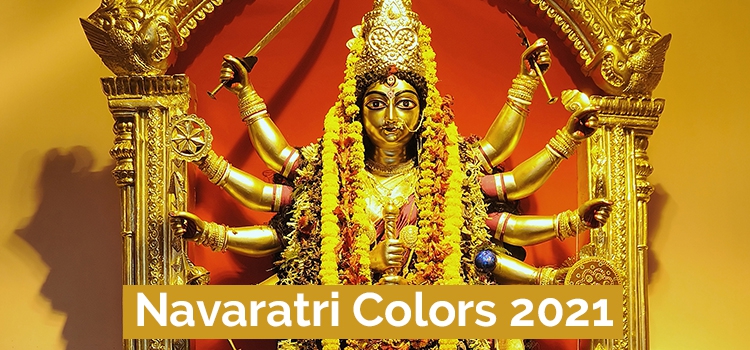Navratri Colors 2021
The festival of Navratri celebrates Goddess Durga in her 9 forms. It is a major Hindu festival in India, and the celebrations go on for 9 days and 9 nights. Navratri means ‘nine nights’. A different form of the Goddess is revered each day. Different states in India tend to celebrate it in different ways. For example, it is Durga Pooja in West Bengal. In Karnataka, it is Dussehra, and in Tamilnadu, it is Golu Pandigai. Hindus observe four seasonal Navratris in a year. They are Shardiya Navratri, Chaitra Navratri, Magha Navratri, and Ashada Navratri.
Shardiya Navratri – Shardiya Navratri is the most significant and popular Navratri. Sharad means autumn this Navratri occurs during September-October. It is also known as Maha Navratri. The mythological story behind Navratri has to do with Mahishasura’s slaying by Navadurga. Also, Lord Rama killed Ravana during this time.
Chaitra Navratri – Next to Shardiya Navratri, it is the most popular Navratri. Chaitra means 'spring'. It is observed during March-April. Vasant Navratri and Rama Navratri are other names for it. The birthday of Rama or Rama Navami is on the ninth day during Chaitra Navratri.
Magha Navratri – This Navratri occurs in the winter season. Its popular name is Vasant Panchami. This occurs during January-February.
Ashada Navratri – This occurs during June-July, when the monsoon season arrives. Devotees observe a fast and perform the Navratri ceremonies four times a year. The fasting is in tune with the seasonal changes and benefits our bodies by aiding digestion and providing immunity against infections caused by the changing climate.
An interesting aspect of Navratri is that each of the 9 days is associated with a particular color. People wear the colors according to the Navratri color calendar. Let us see what are the Navratri colors for Navratri 2021

Join In Our 9 Fire Labs Activate To 9 Life-Transforming Goddesses
Navratri Day 1: Orange
Orange, a bright and vibrant color, is the color for Day 1 of the Navratri festival. This is a color that symbolizes energy and happiness. On the first day, devotees worship Goddess Shailaputri, the daughter of the mountains, whose other names are Parvati, Bhavani, and Hemavati. Goddess Shailaputri has two hands and a crescent moon on her forehead.
Navratri Day 2: White
White, the color of purity and peace, is the color for Day 2 of Navratri. On the second day, devotees worship Goddess Brahmacharini. The white color also signifies meditation. Goddess Brahmacharini is depicted wearing a white dress and holds a rosary in her right hand and a Kamandala in her left hand. She symbolizes wisdom and loyalty. She is also the epitome of love.
Navratri Day 3: Red
On the third day, people wear red. This is the color of beauty and valor. Goddess Chandraganta is worshipped on this day. She is a deity who is known for her grace and courage.
Navratri Day 4: Royal blue
Royal blue is the color of Day 4 of Navratri. The color represents good health and prosperity. Goddess Kushmanda is worshipped on this day. She has eight hands; Ashtabhuja Devi is another name for her.
Navratri Day 5: Yellow
Yellow is the color for Day 5. This color signifies happiness and brightness. On this day, it is Goddess Skandamata who is the object of worship. She is also the mother of Lord Kartikeya/Muruga/Skanda.
Navratri Day 6: Green
The color for Day 6 is green. This color stands for new beginnings and growth. Devotees worship Goddess Katyayani on this day. She is regarded as the slayer of the evil demon, Mahisasura.
Navratri Day 7: Grey
Grey is the color for this day, which stands for the strength of transformation. Goddess Kalaratri is the object of worship on this day. She is the destroyer of all demons, negative energies, ghosts, and evil spirits. Another name for her is Shubankari, as she supposedly bestows auspicious results to her devotees.
Navratri Day 8: Purple
The ritual called Kanjak takes place on Day eight of Navratri. On this day, devotees feed small girls who represent avatars of the Goddess. Purple color speaks of the power of intellect and peace. Hindus worship Goddess Mahagauri on this day. She has the power to fulfill her devotees’ desires. Supposedly, the one who worships her gets relief from all sufferings.
Navratri 9: Peacock green
Day 9, called Navami, is the last day of the Navratri festival, and Goddess Siddhidatri is worshipped on this day. The Navami color is peacock green. Supposedly, one side of Lord Shiva's body is that of Siddhidatri. Hence, he is called Ardhanarishwar. According to the Scriptures, Shiva attained many siddhis by worshipping her.
Now that you know the order and significance of Navratri colors 2021, you can prepare to celebrate Navratri the way it should be – with devotion and understanding.




















